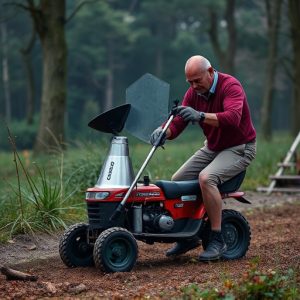Mastering the Kubotan: A Comprehensive Guide on Using This Self-Defense Tool
The Kubotan is a versatile self-defense tool rooted in Eskrima traditions and refined for modern ma…….
The Kubotan is a versatile self-defense tool rooted in Eskrima traditions and refined for modern martial arts, particularly Aikido. It enhances striking power and reach, serving as both an impact weapon and a control device in close quarters. Mastery of the Kubotan's two primary grips—the 'Yellow Belt Grip' for beginners and the 'Black Belt Grip' for advanced users—is crucial for effective use. The 'Yellow Belt Grip' allows for versatility in executing strikes, while the 'Black Belt Grip' enables sophisticated techniques like locks and pressure point strikes. Regular practice of these grips is essential to integrate the Kubotan seamlessly into martial arts training, ensuring it functions as an extension of the user's hand for precise and powerful strikes or non-lethal control options. To effectively use a Kubotan in self-defense, one must master the correct grip, stance, and movement precision through comprehensive training that includes realistic scenario drills. This approach not only enhances personal safety but also diversifies martial arts repertoire by incorporating the strategic use of leverage and precision that the Kubotan offers. Advanced users tailor their Kubotan skills to complement their unique fighting styles, ensuring a cohesive defense mechanism capable of fluidly transitioning between Kubotan techniques and empty-hand maneuvers for dynamic responses to various threat scenarios. How to use a Kubotan effectively involves integrating this tool into one's overall self-defense strategy with consistent training and practice.
Explore the intricacies of the Kubotan fighting system, a formidable self-defense tool that has stood the test of time. This article delves into its origins and evolution, offering insights on mastering Kubotan grips to enhance your martial arts skills. Learn the nuances of integrating Kubotan strikes into your defense strategies and advance your techniques by combining them with empty-hand maneuvers. Whether you’re new to the art or looking to refine your proficiency, understanding how to use a Kubotan effectively is key to personal protection. Join us as we navigate through the various facets of this multifaceted self-defense system.
Understanding the Kubotan: A Versatile Self-Defense Tool
The Kuboton is an increment..ononononononononononononononononononononononononononononononon
The History and Development of Kubotan Techniques
The Kubotan is a self-defense tool that has its roots in the Philippine martial art of Eskrima and was further developed by the late Master Frank A. Karszewski, a pupil of Eskrima Grandmaster Angel Cabales. This compact, key-like device is designed to extend the range and striking power of the hand, allowing users to deliver precise, powerful blows while also providing a means of control and defense against larger adversaries. The history of Kubotan techniques is intertwined with the evolution of self-defense training, as instructors adapted traditional Eskrima principles to incorporate this innovative tool. Over time, practitioners discovered various applications for the Kubotan, including its use as an impact weapon and a control device in close-quarters combat. The development of Kubotan techniques has been influenced by the need for effective self-defense strategies that can be employed in real-world scenarios. Today, the Kubotan is a respected component of many martial arts systems, with instruction on how to use a Kubotan often integrated into self-defense curricula. Practitioners learn to manipulate the Kubotan with precision, combining it with traditional striking techniques and defensive maneuvers to neutralize threats and protect themselves in potentially dangerous situations. The technique’s effectiveness lies in its adaptability; it can be used both as a last resort and as part of a comprehensive self-defense strategy, making it an essential tool for those seeking to enhance their personal safety through martial arts training.
Mastering Kubotan Grips for Maximum Efficiency
Mastering the Kubotan grips is a fundamental aspect for practitioners seeking to utilize this self-defense tool to its full potential. The Kubotan, a short, thick stick with a blunt end, extends a martial artist’s range and amplifies strikes, providing a tactical advantage in close-quarters combat. To effectively wield the Kubotan, one must first familiarize themselves with the various grips that enable precise control over the tool. The ‘Yellow Belt Grip’ is the most basic and involves holding the Kubotan horizontally at its center, allowing for smooth transitions between strikes and defenses. Advanced users can explore the ‘Black Belt Grip,’ where the thumb rests on top of the Kubotan, providing a firmer hold necessary for more complex techniques involving locks, controls, and strikes to pressure points. Understanding how to use a Kubotan with proficiency in these grips is crucial for its application in self-defense scenarios. Practitioners should practice each grip until they become instinctive, ensuring the Kubotan becomes an extension of their hand and arm. This mastery of grips allows for the delivery of precise strikes with greater force while also providing options for non-lethal control measures when necessary. Regular training and drilling will reinforce proper technique, leading to maximum efficiency in the use of the Kubotan within the context of the martial arts system it is part of.
Integrating Kubotan Strikes into Your Martial Arts Repertoire
The Kubotan is a versatile self-defense tool that has gained prominence within various martial arts due to its effectiveness in neutralizing threats. Integrating Kubotan strikes into your martial arts repertoire can significantly enhance your defensive capabilities, particularly in close-quarters combat scenarios. To effectively use a Kubotan, one must first understand its design and purpose. The Kubotan’s length and weight allow for a variety of techniques, including strikes, blocks, and control holds. Practitioners should familiarize themselves with the correct grip and stance to maximize control and power during training.
Mastery of the Kubotan involves practicing precise movements and understanding its applications in conjunction with empty-hand techniques. It’s crucial to train with a qualified instructor who can guide you through the nuances of Kubotan strikes, ensuring safety and proper execution. Incorporating drills that simulate self-defense situations will help you apply the Kubotan effectively when under pressure. These drills should cover various angles of attack and defense, teaching you how to use a Kubotan to strike vulnerable points on an opponent’s body, such as the eyes, nose, and joints. By integrating this specialized weapon into your martial arts training, you can diversify your defensive arsenal, adding a layer of security that relies on the strategic use of leverage and precision.
Advanced Strategies: Combining Kubotan with Empty-Hand Techniques
The Kubotan is a versatile self-defense tool that, when integrated with empty-hand techniques, significantly enhances one’s martial arts arsenal. Practitioners of the Kubotan fighting system can expand their defensive capabilities by combining its use with traditional hand-to-hand combat skills. This synergy allows for a more dynamic and adaptable self-defense strategy, as the Kubotan can be used to extend reach, apply pressure, or deliver precise strikes, while empty-hand techniques handle closer-range confrontations. To effectively integrate the Kubotan into one’s fighting repertoire, it is essential to understand how to use a kubotan in conjunction with hand movements and body positioning. Training should focus on fluid transitions between using the Kubotan and employing empty-hand maneuvers, creating a seamless defense mechanism that can adapt to various threatening scenarios.
Advanced practitioners often explore how to use a kubotan in a way that complements their natural fighting style, whether it be striking, grappling, or a mix of both. This involves practicing combinations that flow naturally from a Kubotan technique to an empty-hand follow-up and vice versa. For instance, one might use the Kubotan to disarm an attacker and then switch immediately to close-quarters combat, delivering knee strikes or clinch maneuvers without missing a beat. The integration of these two disciplines requires a deep understanding of both the tactical applications of the Kubotan and the nuances of empty-hand techniques. It is through dedicated training and realistic drills that one can master how to use a kubotan in unison with their physical capabilities, thereby enhancing their self-defense skills against a wide array of threats.


